
Contributed by Mike Smolinski
Please report any broken links or trouble you might come across to the Webmaster. Please take a moment to let us know so that we can correct any problems and make your visit as enjoyable and as informative as possible.


|
||||||



|
||||||
 |
||||||
 |


|
|||||
 |
||||||
Built by Newport News. Initially named Kearsarge; renamed to honor CV-8. Laid down 3 August 1942, launched 30 August 1943, commissioned 29 November 1943. Decommissioned to reserve 15 January 1947.
Briefly recommissioned in 1951, then underwent an SCB-27A modernization at the New York Naval Shipyard. Redesignated as an "attack carrier" (CVA-12) on 1 October 1952. Recommissioned on 11 September 1953. Modernized again (SCB-125) in 1956, at the Puget Sound Naval Shipyard. In mid-1958, Hornet was converted to an antisubmarine warfare support carrier in the Puget Sound Naval Shipyard, and redesignated CVS-12.
Fate: Decommissioned for the last time on 26 June 1970. Struck from the Naval Vessel Register on 25 July 1989 and sold for breaking up. However, she was saved by the efforts of historically-minded citizens and donated to the Aircraft Carrier Hornet Foundation for use as a museum on 26 May 1998; she is currently at Pier 3, Alameda Point, Alameda, Ca. Listed on the National Register of Historic Places, ref. no. 91002065, and designated a National Historic Landmark, 4 December 1991.
| Click On Image
For Full Size Image |
Size | Image Description | Contributed
By And/Or Copyright |
|
|---|---|---|---|---|
| Name |
||||
 NS020869a |
145k | CV-12 was named to commemorate seven American warships that had previously borne the name. A hornet is a large, strong wasp whose sting is severe (NS020869a). Hornets are the largest of the eusocial wasps, and are similar in appearance to their close relatives yellowjackets (wasps native to North America—e.g., baldfaced hornets—are commonly refered to as hornets but are actually yellowjackets). Hornets aggresively guard their nesting sites when threatened and their stings are more painful and dangerous to humans than typical wasp stings, as their venom contains a large amount of acetylcholine; moreover, individual hornets can sting repeteadly. Previous Hornets:
NS020869a: European hornet. Photo by PiccoloNamek, via Wikipedia. NS020801: The seventh Hornet, CV-8, as completed, 27 October 1941. National Archives and Records Administration (# 80-G-463613). 020869: "A nest of Hornets." "Hornets have been buzzing around our enemies' ears ever since 1775." USN, All Hands magazine, February 1958 issue (pages 18–20). |
NavSource | |
 NS020801 |
336k | |||
 NS020869 |
1.19M | |||
| The Early Years — World War II |
||||
NS0212aj |
535k | USS Hornet (CV-12), World War II. Overhead plan and starboard profile meticulously drawn by John Robert Barrett. |
Navy Yard Associates | |
 NS021237a |
96k | Secretary of the Navy Frank Knox and his wife, Mrs. Annie Reid Knox, ship's sponsor, at Hornet's christening ceremonies, 30 August 1943. The carrier was built at the Newport News Shipbuilding and Dry Dock Company shipyard, Newport News, Virginia. U.S. Naval Historical Center Photograph (# NH 53429). |
NHC | |
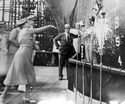 NS021237c |
769k | As above. |
S. Dale Hargrave | |
 NS021237b |
158k | Bow view of launching of the future USS Hornet (CV-12), showing original bow configuration, 30 August 1943. National Archives photo (# 80-G-43009). |
The Library of Congress, via Mike Green | |
 NS021237 |
119k | Launching, 30 August 1943, at Newport News on the James River. |
Steve Whitby | |
 NS0212ap |
255k | Port quarter view of USS Hornet (CV-12) as completed. Norfolk Navy Yard, 19 December 1943. US Navy and Marine Corps Museum/Naval Aviation Museum, Photo No. 1996.488.245.003. |
Mike Green | |
 NS0212apa |
228k | Overhead bow view of USS Hornet (CV-12) underway on 19 December 1943, leaving Norfolk Navy Yard, beginning her shakedown period. US Navy and Marine Corps Museum/Naval Aviation Museum, Photo No. 1996.488.245.006. |
Mike Green | |
 NS0212apb |
201k | Port bow view of USS Hornet (CV-12) off Norfolk Navy Yard, 19 December 1943. Norfolk Navy Yard photo serial 6724(43). She is, as commissioned, in Measure 33, Design 3A camouflage scheme. US Navy and Marine Corps Museum/Naval Aviation Museum, Photo No. 1996.488.245.004. |
Mike Green | |
 NS021201 |
16k | Small overhead as built. Appears to have been taken on the same occasion as the photos above. |
USN | |
 NS021204 |
112k | USS Hornet (CV-12). Pristine when they left the shipyards, the carriers looked rag torn and dirty after a few months of wartime flight operations. The dazzle camouflage didn't help their clean line appearance. | USN | |
 NS021225 |
110k | Unusual view of Hornet's flight deck. |
Steve Whitby | |
 NS021225a |
86k | |||
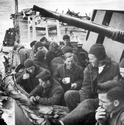 NS0212bu |
383k | Getting some rest by one of the quad 40-mm mounts. Date and location unknown. |
Courtesy of Scott Koen & ussnewyork.com | |
 NS021222 |
136k | Stern view just before her shakedown cruise, Dec. 1943. (National Archives photo). |
Steve Whitby Larger copy courtesy of Scott Koen & ussnewyork.com |
|
 NS0212am |
121k | Full aerial view of USS Hornet (CV-12) off Norfolk, Va., showing original stern configuration and axial flight deck, 19 December 1943. National Archives photo (# 80-G-206000). |
Mike Green | |
 NS0212bh |
94k | First airplane landing on CV-12 USS Hornet performed by Commander, Air Group 15, Commander William M. Drane in a TBF-1 Avenger, 1 January 1944. National Archives and Records Administration (photo # 80-G-367058). |
Tracy White, Researcher @ Large | |
 NS021235 |
124k | View of the island of USS Hornet (CV-12). Note the SM radar antenna (the "dish" fitted at the fore end of the mast platform). Hornet was the first ship of her class to receive this fighter-control radar. This photo is dated 23 January 1944. National Archives photo # 80-G-367081. (Thanks to Tracy White, Researcher @ Large.) |
Pieter Bakels | |
 NS021272 |
73k | USS Hornet (CV-12) underway in January 1944 during her shakedown in the Atlantic, before Air Group 15 came aboard. She is wearing Measure 33, Design 3A camouflage. There are only four radio masts on the starboard side of the flight deck, and the hangar catapult outrigger is in the stowed position. In place of a third Mk 37 director, a 40-mm quad mount was fitted at the same level as the flight deck. Note the hull number on the flight deck is unusually painted facing "the other" way — this was corrected before she entered combat. (Thanks to Steve Whitby, who provided additional information.) |
Robert Hurst | |
 NS021231a |
134k | The Atlantic Ocean, January 1944. Training accidents during a ship and airgroup shakedown and workup were not infrequent. This Helldiver from VB-15 (# 15-B-25) had its tail chewed off by another SB2C (see below). |
Steve Whitby | |
 NS021231 |
141k | The Atlantic Ocean, January 1944. This Helldiver chewed off the tail of another Helldiver (# 15-B-25, see above). Crews in both aircraft were hurt; note crewman carrying a stretcher. National Archives photo. |
Steve Whitby Larger photo submitted by Pieter Bakels |
|
 NS0212bl |
618k | An F6F-3 Hellcat of Fighting Squadron (VF) 15 launches from the hangar deck catapult of USS Hornet (CV-12) during training in Chesapeake Bay, 12 February 1944. The early Essex-class carriers had been built with a hangar-level catapult, called the HIVA catapult (actually, H-4A) that shot planes out of the starboard forward hangar deck. Since the aircraft could not benefit from the ship steaming into the wind, these catapults were deemed unpractical, and replaced with a second flight deck catapult. They were removed during refits in 1944 because they didn't get a lot of use. Hornet was the only carrier to keep her HIVA hangar-deck catapult until the end of the war. |
Bill Gonyo | |
 NS021236 |
113k | This photo was taken on 4 March 1944 as Hornet was tying up to the mooring at Fox 9 Ford Island, Pearl Harbor with Air Group 15 on the flight deck. The photo was taken from Essex (CV-9) who would soon be taking Air Group 15 aboard while Hornet would take Air Group 2 into her first combat with the Japanese. |
Steve Whitby | |
 NS021236a |
699k | As above, uncropped. Photograph received on 9 February 1945. National Archives and Records Administration (NARA) photo, # 80-G-300927. |
NARA | |
 NS0212cf |
400k | USS Hornet (CV-12) departing Pearl Harbor, Territory of Hawaii. Photo is dated 22 March 1944, but Hornet actually left Pearl on 15 March and set course for Majuro, Marshall Islands—on 22 March she left Majuro with Task Group 58.2 for operations against Japanese islands. National Archives and Records Administration (NARA) photo, # 80-G-K-6979. |
Via Michael Mohl | |
 NS0212au |
368k | "This series of photographs was taken on USS Hornet (CV-12) during a 'Crossing The Line' ceremony (either the Equator or the International Date Line, or possibly both) in 1944. The photographs were taken by Photographer's Mate 2/Class Paul D. Guttman. He happened to be on board the Hornet when she crossed both the Equator and the International Date Line, and there were separate initiation ceremonies for both occasions, so it is possible these pictures may have been taken on two separate occasions." Hornet crossed the Equator for the first time on 25 March 1944. |
Robert Guttman | |
 NS0212aua |
272k | |||
 NS0212aub |
332k | |||
 NS0212auc |
243k | |||
 NS0212aud |
258k | |||
 NS0212aue |
253k | |||
 NS0212auf |
285k | |||
 NS021264 |
152k | A close-up of Hornet's hangar deck catapult with Air Group 2 on the flight deck; 1944. |
Steve Whitby | |
 NS0212aa |
165k | VF-2 pilots manning their F6F-3 Hellcats for a raid against Truk, May 1944. |
Steve Whitby | |
 NS021232 |
105k | Good bow shot of Hornet in original form tied up at Majuro, May 29, 1944. National Archives photo # 80-G-242616. |
Steve Whitby | |
NS021232a |
636k | USS Hornet (CV-12), Majuro, 29 May 1944. Camouflage is Measure 33, Design 3A. The colors are Navy Blue (5-N), Haze Gray (5-H), and Pale Gray (5-P). NS021232a: National Archives and Records Administration (NARA) photo, #80-G-242591. NS021232b: National Archives and Records Administration (NARA) photo, #80-G-242589. |
Courtesy of usndazzle.com, via Mike Green |
|
NS021232b |
560k | |||
NS021273 |
80k | USS Hornet (CV-12) recovering an SB2C Helldiver from VB-2, June 1944. |
Steve Whitby | |
 NS021291 |
128k | "ENS F. T. Long from Torpedo 2 [VT-2] wrote off TBM-1C BuNo 45593" in June 1944. Both photos appear to have been taken within seconds from each other. (NS021291): It looks like the landing gear collapsed, perhaps because the hydraulics of #93 had been shot out. This picture shows to good advantage the "Net" that the LSO dove into if there was a problem. (NS021291a): Apparently #93, its engine and starboard wing ripped off, had already been hit some time earlier, as attested by the still unpainted fabric patch on its rudder. |
Steve Whitby | |
 NS021291a |
324k | Steve Whitby Larger photo submitted by Pieter Bakels |
||
NS0212bj |
98k | On the evening of 20 June [1944], Task Force 58 launched more than 200 aircraft on a maximum range strike against the Japanese carriers withdrawing from "The Marianas Turkey Shoot." Hornet's VT-2 contributed six Avengers to the "Mission Beyond Darkness," flying through heavy clouds near the Japanese Mobile Fleet. (Text from TBF/TBM Avenger Units of World War 2, by Barrett Tillman (Osprey Publishing, 1999)). |
Steve Whitby | |
 NS0212at |
112k | A starboard side view of USS Hornet (CV-12), with Air Group (CVG) 2 aboard, July 1944. Her dazzle pattern (Measure 33, Design 3A) was still in good shape then. |
Steve Whitby | |
 NS0212ay |
13k | A Curtiss SB2C Helldiver that failed to catch the wire on landing and hit the first barrier, nose-diving into the deck, breaking the engine mounts, rupturing fuel lines and starting a fire. It was quickly extinguished and cleared out of the way so that further aircraft could continue to land. USS Hornet, 3 July 1944. Photo from daveswarbirds.com. |
Robert Hurst | |
 NS021248 |
578k | TBM/TBF-1C Avengers of Torpedo Squadron (VT) 2 pass over USS Hornet (CV-12) prior to entering the carrier's landing pattern, August 1944. National Naval Aviation Museum photo, # 1996.253.1089. |
Steve Whitby Mike Green |
|
 NS021233 |
162k | Hornet's flight deck and island taken while at anchor in Eniwetok Atoll, 26 August 1944. This was a ceremony in which Admiral Mitscher, Commander of TF-58, honored the ship, crew, and Air Group 2 for their part in the conquest of the Marianas Islands. The ship anchored off Hornet's starboard side is USS Essex (CV-9). The light carrier is USS San Jacinto (CVL-30). |
Steve Whitby | |
 NS0212bo |
333k | Extremely rare photo of TBF-1C Avenger #95 from VT-2, USS Hornet (CV-12), September 1944, being photographed because it had survived 53 bombing missions and three torpedo attacks against Japanese targets in the Palaus, Carolines, the Bonins, New Guinea, the Marianas and the Philippines. What a combat veteran! |
Steve Whitby | |
 NS0212bf |
100k | Full starboard view of USS Hornet (CV-12) underway on 5 September 1944. She is painted in Measure 33, Design 3A, camouflage. National Archives and Records Administration (NARA photo, # 80-G-284087. |
Mike Green | |
 NS021226 |
246k | The second Fighting Two squadron (VF-2), "Rippers," later "Tall Dogs," was established on 1 June 1943. It made two combat deployments, one aboard USS Enterprise (CV-6), November 1943–January 1944, and one aboard USS Hornet (CV-12), March–September 1944. Its first commanding officer, and leading ace, was Commander William A. Dean. VF-2 was disestablished on 9 November 1945. David LaMar Berrey was a pilot between 1943–1944. His brother, Boyd Berrey, also served on the Hornet and trained with "Pappy" Boyington in 1941. |
Joan Rands, daughter of David LaMar Berrey | |
 NS021226b |
52k | Tommy Trampp | ||
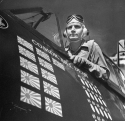 NS021226c |
277k | Navy pilot CDR William A. Dean, commanding officer of Fighting Squadron (VF) 2 "Rippers," sitting in his fighter plane emblazoned with 11 Japanese flags indicating his count of confirmed kills in 1944. VF-2 had become top fighter squadron in the Pacific with more total victories and more ace pilots than any other fighter squadron. Photo courtesy of Life Magazine. |
Bill Gonyo | |
 NS021226a |
120k | "Jocko Jima" certificate awarded to flight crew of Air Group 2 by ADM Joseph J. "Jocko" Clark. |
Steve Whitby | |
 NS0212az |
158k | CVG-11 preparing to launch a strike in late 1944. Nine Grumman F6F-5 Hellcats (most armed with HVARS) are turning up ahead of eight Grumman TBM-3 Avengers and nine Curtiss SB2C-3 Helldivers. Aside from the white ball on the vertical stabiliser, Hornet Hellcats and Avengers sported white propeller hubs to enhance recognition in flight. Photo courtesy of the Tailhook Association. Photo and text from VF-11/111 "Sundowners" 1942–95 (Aviation Elite Units #36), by Barrett Tillman. |
Robert Hurst | |
 NS0212ae |
194k | Overhead view of an ammo ship replenishing USS Hornet (CV-12), October 1944. Note the forward antenna masts half way up. |
Steve Whitby | |
 NS0212bt |
650k | View of one of the Japanese fleets that participated in the Battle of Leyte Gulf, taken from a US Navy plane as it swoops to the attack off Samar. Photograph includes battleships Yamato, Nagato, and Kongo-class Haruna. Photographed by W.G. Eccles of USS Hornet (CV-12), 25 October 1944. Photograph released 9 November 1944. National Archives and Records Administration (NARA) photo, # 80-G-46989. |
NARA | |
 NS021666 |
213k | "A message from the first Commanding Officer of the first modern Hornet," VADM Marc A. Mitscher, Commander First Carrier Task Force, "to the Officers and Men of Task Force Thirty-Eight." Ulithi Atoll, 30 October 1944. Mitscher's flagship at the time was USS Lexington (CV-16). Quoted for the information of all hands aboard the second modern Hornet (CV-12). |
Robert M. Cieri | |
 NS021265 |
134k | A VF-11 F6F getting a wave off while another Hellcat taxies out of the way, Dec. 1944. |
Steve Whitby | |
 NS021274 |
163k | The famous "Murderers Row" at Ulithi lagoon, December 1944, as seen from USS Wasp (CV-18): USS Yorktown (CV-10), USS Hornet (CV-12), and USS Hancock (CV-19). |
Steve Whitby | |
 NS021214 |
571k | Curtiss SB2C-3 Helldiver aircraft bank over USS Hornet (CV-12) before landing, following strikes on Japanese shipping in the China Sea, circa mid-January 1945. Photographed by Lieutenant Commander Charles Kerlee, USNR. Official U.S. Navy Photograph, now in the collections of the National Archives (photo # 80-G-469319). |
Scott Dyben Bob Fish, Trustee, USS Hornet Museum |
|
 NS021214a |
589k | "A Navy Curtiss Helldiver (SB2C) is snapped against the background provided by its carrier as it returns from a strike at Jap shipping. Far below other planes are being spotted on the flight deck to which the SB2C will soon return." Other details as above. Official U.S. Navy Photograph, now in the collections of the National Archives and Records Administration (NARA), photo # 80-G-320999. |
NARA | |
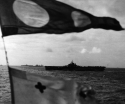 NS0212cm |
921k | USS Hornet (CV-12) at sea launching planes of Combat Air Patrol during fueling exercises in the Philippine Sea, as seen from USS Sargent Bay (CVE-83), 23 January 1945, a day after the last strike of that cruise against Okinawa. A battleship—either USS New Jersey (BB-62) or USS Wisconsin (BB-64)—and an aircraft carrier—either USS Lexington (CV-16) or USS Hancock (CV-19)—can be seen beyond Hornet. National Archives and Records Administration (NARA) photo, # 80-G-263985. |
NARA | |
 NS021275 |
153k | A mix of Hellcats. Flat windscreen F6F-5s and round windscreen -3s from VF-11, late January 1945, launching for strikes against Formosa. |
Steve Whitby | |
 NS021238 |
139k | Hornet and Independence (CVL-22) together, 25 January 1945, as seen from Lexington (CV-16). National Naval Aviation Museum, photo # 1996.488.245.010. Robert L. Lawson Photograph Collection. |
Steve Whitby Mike Green |
|
 NS021234 |
112k | Bombs being transferred to Hornet from ammo ship off Iwo Jima, February 1945. Note one of VF-11's F6F's with geometric white squares on the tail denoting CV-12, parked on the forward flight deck and the heavy weathering and rust on the original dazzle paint on her forward hull. The USS Hornet was the first Essex-class carrier to be painted in dazzled paint (November 29, 1943) and one of the last to have it painted out (July 1945). National Archives photo. |
Steve Whitby | |
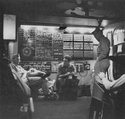 NS0212bi |
66k | USS Hornet (CV-12) ready room, February 1945. National Archives and Records Administration (photo # 80-G-469242). |
Tracy White, Researcher @ Large | |
 NS021242 |
105k | 40mm Quad Machine Gun Mount firing on board USS Hornet (CV-12), circa February 1945, probably during gunnery practice. The original picture caption identifies the photo as having been taken during Task Force 58's raid on Japan, 16 February 1945. However, helmetless members of the gun crew, and rolled up shirt sleeves, strongly indicate that the occasion was in warmer climes and not while in combat. View looks aft on the port side, with the carrier's port quarter 5"/38 guns just beyond the 40mm mount. Note ready-service ammunition and spent shell casings at right; men passing 4-round clips to loaders at left. Official U.S. Navy Photograph, now in the collections of the National Archives (photo # 80-G-413915). |
Pieter Bakels | |
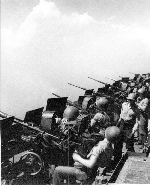 NS015705u |
303k | Aboard USS Hornet (CV-12), 20mm gun crews stand by as her planes hit Tokyo, Japan. Photograph by Lieutenant Commander Charles Kerlee, released February 1945, TR-13629. Official U.S. Navy Photograph, now in the collections of the National Archives and Records Administration (NARA), # 80-G-469289. |
Photo submitted by Pieter Bakels | |
 NS0212bc |
148k | "Number CV12-1411, 9 Feb. 1945, USS Hornet—Ernie Pyle, war correspondent visits the USS Hornet (CV-12) and chats with Comdr. W.E. Gailard and Lt.(jg) Frank R. Reynolds." "With Comdr. W.E. Gaillard in entry port and Lt.(jg) Frank R. Reynolds at top of ladder and to right." National Archives photo (# 80-G-317021). |
Tracy White, Researcher @ Large | |
 NS0212bm |
78k | LT George Edward Ford was born near Orosi, California on 20 January 1919. He attended San Jose State College before enlisting in the Navy in March 1941. After flight training at Corpus Christi, Texas, in March 1942 he was designated a Naval Aviator and commissioned in the rank of Ensign in the U.S. Naval Reserve. Assigned to Bombing Squadron (VB) 11, during May–July 1943 Ford flew combat missions from Guadalcanal's Henderson Field during the initial phases of the campaign to drive the Japanese from the central Solomon Islands. In the last several months of 1944 and the first part of 1945 Ford, now holding the rank of Lieutenant and still serving with VB-11, was based on the aircraft carrier USS Hornet (CV-12). He took part in the October raids against enemy bases in the Philippines, Okinawa and Formosa, and in the Battle of Leyte Gulf. A successful attack on the huge battleship Yamato on 25 October 1944 was recognized by the award of the Navy Cross. Following the Leyte battle, Ford flew additional missions against targets in the Philippines, coastal China and Formosa. Navy Cross Citation: "The President of the United States takes pleasure in presenting the Navy Cross to George Edward Ford, Lieutenant, U.S. Navy (Reserve), for extraordinary heroism in operations against the enemy while serving as Pilot of a carrier-based Navy Combat Plane deployed over Samar in action against enemy Japanese forces during the Battle of Leyte Gulf, on 25 October 1944, in the Philippine Islands. Lieutenant, Junior Grade, Ford's outstanding courage, daring airmanship and devotion to duty were in keeping with the highest traditions of the United States Naval Service." Photo courtesy of the U.S. Naval History and Heritage Command. |
Bill Gonyo | |
 NS0555607 |
130k | As seen from USS Essex (CV-9), destroyer USS Hailey (DD-556) refuels from an unidentified ship, with USS Hornet (CV-12) in the middle distance (painted in camouflage Measure 33, design 3A) and USS Enterprise (CV-6) in the background. Location and date unknown (probably sometime in February–May 1945). |
Pieter Bakels | |
 NS021266 |
126k | Hornet, showing heavy weathering and rust after more than a year of sustained combat and salt water, anchored at Ulithi on March 6, 1945 with Air Group 17 on deck. LCI(L)-1052 is in the foreground. |
Steve Whitby | |
 NS021276 |
164k | One of VB-17's SB2C Helldivers taxiing out for launch, March 1945. |
Steve Whitby | |
 NS021223 |
136k | Hornet recovering and Bennington (CV-20) launching aircraft off the coast of Japan, March 1945. (National Archives photo). |
Steve Whitby | |
 NS021249 |
153k | March 1945, with Air Group 17 on the flight deck. National Archives. |
Steve Whitby | |
 NS0212ct |
308k | A very small photo (about 2½" square) so it is pretty grainy. F6F-5s Hellcats from Fighting Squadron (VF) 17 "Jolly Rogers," preparing to launch for a strike, March 1945. The connected squares on the tail indicated they were from USS Hornet (CV-12). This was used for a short time by Carrier Air Group (CVG) 11 in January 1945 and by CVG-17 for their entire tour of duty aboard Hornet from February till June 1945. |
Steve Whitby | |
 NS0212ab |
189k | Another aerial view of USS Hornet (CV-12) during operations off Okinawa, in March 1945, with Air Group 17 aboard. |
Steve Whitby | |
 NS0212ax |
1.39M | Another aerial view of USS Hornet (CV-12) underway, that might have been taken at the same time as the photos above (NS021249 & NS0212ab). |
Wolfgang Hechler | |
 NS021215 |
87k | USS Hornet (CV-12) operating near Okinawa, 27 March 1945. The ship is painted in camouflage Measure 33, Design 3a. Official U.S. Navy Photograph, now in the collections of the National Archives (photo # 80-G-K-14466). |
Scott Dyben | |
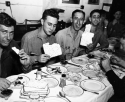 NS021215a | 87k | Jewish Passover, 27 March 1945, aboard USS Hornet (CV-12). Official U.S. Navy Photograph, now in the collections of the National Archives and Records Administration (NARA), # 80-G-367376. |
NARA | |
 NS021224 |
59k | Hornet under attack as seen from Bennington (CV-20), April 1945. Photo by Lowell Love. |
Steve Whitby | |
 NS021297 |
87k | USS Hornet (CV-12), along with USS Bennington (CV-20), shooting down a kamikaze off Okinawa, April 1945. |
Steve Whitby | |
 NS021267 |
169k | A grainy shot of Hornet's TBM Avengers and SB2C Helldivers from Air Group 17 preparing for launch, April 1945. |
Steve Whitby | |
 NS021285 |
77k | Unique shot of a VF-17 Hellcat being lowered down Hornet's deck edge elevator showing her geometric tail and wingtip design, April 1945. |
Steve Whitby | |
 NS0212bp |
25k | "After the Solomons—In late 1944 a new VF-17 was formed and operated aboard the carrier USS Hornet. Although slow to take up the traditions of the original VF-17 'Jolly Rogers' the new unit flying F6F Hellcats destroyed 161 Japanese aircraft between February and May 1945. Like the original VF-17 the Hornet's 'Jolly Rogers' had 12 pilots make ace status." |
Tommy Trampp | |
 NS021286 |
51k | TBM-3 Avengers from VT-17 attacking targets around Tokyo, possibly in April 1945. |
Steve Whitby | |
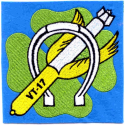 NS0212cl |
104k | Torpedo Squadron (VT) 17 patch. |
William L. Williams, for his father's cousin, Robert H. Williams | |
 NS0212av |
252k | "A Kamikaze just misses USS Hornet. This picture was taken on the USS Hornet (CV-12) off Okinawa during April 1945 by Photographer’s Mate 2/c Paul D. Guttman, and it was definitely not taken with a telephoto lens! The black specks visible in the midst of the blast aren't flaws in the film, they're bits of shrapnel from the exploding plane. Paul was knocked unconscious by the blast, and came to later, in sick bay. He wasn't even aware that he'd taken this picture until sometime later, after the film was developed!" "The other carrier visible in the background, wreathed in smoke from the firing of her own AA guns, is supposedly USS Intrepid (CV-11) [(?)]." |
Robert Guttman | |
 NS0212bg |
129k | Forward flight deck view, from the port side, of the island of USS Hornet (CV-12) in April 1945. Grumman F6F Hellcat fighters from Fighting Squadron (VF) 17 "Jolly Rogers" can be seen on deck, as well as the bridge superstructure with its radar antennas, 40-mm and 5" gun mounts. National Archives and Records Administration (NARA) photo, # 80-G-469299. |
Mike Green | |
 NS021277 |
178k | Sixteen F6F Hellcats from VF-17 running up their Pratt & Whitney R-2800's on April 6, 1945 to attack the Japanese battleship Yamato and her escorts. |
Steve Whitby | |
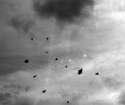 NS021277a |
387k | Operation Ten-Go. Japanese suicide plane climbing then making a spectacular fall after being hit by anti-aircraft fire from Task Force 58. Image taken from USS Hornet (CV-12), 6 April 1945, while off Okinawa. During the invasion, Hornet's planes provided support. National Archives and Records Administration (NARA) photo, # 80-G-331602. |
NARA | |
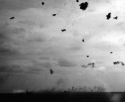 NS021277b |
574k | Operation Ten-Go. Japanese suicide plane splashing after being hit by anti-aircraft fire from Task Force 58. Image taken from USS Hornet (CV-12), 6 April 1945, while off Okinawa. During the invasion, Hornet's planes provided support. National Archives and Records Administration (NARA) photo, # 80-G-331604. |
||
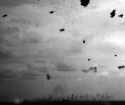 NS021277b1 |
474k | Operation Ten-Go. Japanese suicide plane splashing after being hit by anti-aircraft fire from Task Force 58. Image taken from USS Hornet (CV-12), 6 April 1945, while off Okinawa. During the invasion, Hornet's planes provided support. Crop of photo above. National Archives and Records Administration (NARA) photo, # 80-G-331604a. |
||
 NS0212cc |
217k | F6F-5 Hellcats from Fighting Squadron (VF) 17 on the flight deck of USS Hornet (CV-12). VF-17 was with Hornet from early February 1945 till after the June 5th typhoon crushed the forward flight deck. |
Steve Whitby | |
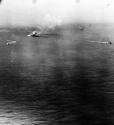 NS0212bz |
616k | Ten-Go Operation, April 1945. Japanese battleship Yamato blows up after receiving massive bomb and torpedo damage from U.S. Navy carrier planes, north of Okinawa, on 7 April 1945. Photographed by planes from USS Hornet (CV-12). Three Japanese destroyers are nearby. NS0212bz: Official U.S. Navy Photograph, now in the collections of the National Archives and Records Administration (NARA), #80-G-320641. NS0212bza: Official U.S. Navy Photograph, now in the collections of the National Archives and Records Administration (NARA), #80-G-320642. |
NARA | |
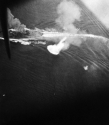 NS0212bza |
430k | |||
 NS021216 |
77k | View looking aft from the ship's island as she steams with other carriers during a western Pacific gunnery practice session, circa June 1945. Next ship astern is USS Bon Homme Richard (CV-31), firing her 5"/38 battery to starboard. Two small aircraft carriers (CVL) are beyond her. Note yellow flight deck markings on Hornet and TBM and SB2C aircraft parked aft. Official U.S. Navy Photograph, now in the collections of the National Archives (photo # 80-G-K-5702). |
Scott Dyben | |
 NS021252 |
110k | Photo taken from the bridge on the morning of June 5th, 1945 just as the first 24 feet of the flight deck get smashed to splinters by the typhoon. The forward antenna mast has left the ship!. National Archives. |
Steve Whitby | |
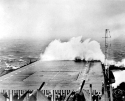 NS021252a |
204k | Same as above, cropped differently. National Naval Aviation Museum (NNAM) photo, # 1996.488.245.001. |
Mike Green | |
 NS021292 |
88k | A VT-17 TBM-3E Avenger on top of a VF-17 F6F-5 Hellcat, June 6, 1945 the day after the typhoon. |
Steve Whitby | |
 NS021203 |
103k | Shown here after weathering a typhoon on June 4–5, 1945. She continued on despite the damage and when it was too dangerous to launch over the bow, she backed into the wind until there was enough wind across the deck to safely launch planes. Compare these photos to those of Wasp (CV-18) and Bennington (CV-20). |
Tracy White, Researcher @ Large See additional photos and read "Flight deck structural failure and collapse during June 1945 Typhoon" at the Researcher @ Large website. Larger copy submitted by Steve Whitby. |
|
 NS021203b |
123k | Steve comments: "Here's another unique photo taken the day after the June 1945 Typhoon aboard the Hornet. My Dad [Robert Whitby] is in the picture somewhere on the island. Admiral Clark ordered the CAP to be launched off the fantail because from what Dad told me, an orphan F4U from another carrier was 'chosen' to try it off the smashed bow. Dad said because of the updrafts from the bent flight deck, the Corsair did a back flip and ended up in the water. The pilot was picked up by a destroyer. It was a big deal as you can see by all the people watching one of VF-17's F6F-5's on his takeoff roll." |
Steve Whitby. | |
 NS021203a |
80k | This photo, showing damage from the typhoon of 4–5 June 1945, was taken probably from USS Blue Ridge (AGC-2) sometime during the period 29 June 1945 to 2 July 1945 at Pearl Harbor when USS Hornet (CV-12) stopped on her way from the Philippines to Hunters Point Naval Shipyard, San Francisco. Blue Ridge was at Pearl for repairs and overhaul for the period from 28 June 1945 to 8 September 1945. |
Michael Patrick in honor of his father John J. Patrick RT 3/c, USS Blue
Ridge (AGC-2), 1943–1945. Date confirmation via deck logs by John Chiquoine. |
|
 NS021268 |
47k | View of port section of flight deck forward. |
Tracy White, Researcher @ Large See additional photos and read "Flight deck structural failure and collapse during June 1945 Typhoon" at the Researcher @ Large website. |
|
 NS021268a |
56k | View of port section of flight deck where folded, taken from forecastle deck looking forward. This section contains the Forward Emergency Radio Room, Motor Generator Room and one gasoline filling station. |
||
 NS021270 |
30k | View of bottom flange of bent at Frame 8, showing twist. |
||
 NS021271 |
61k | View of under starboard side of extreme forward flight deck, where collapsed. Taken from centerline. |
||
 NS0212ar |
189k | "Commendation of Flagship," USS Hornet (CV-12), from Commander Carrier Division Five, RADM Joseph J. "Jocko" Clark. Although no date is visible, it must have been issued during the first half of June 1945. |
Robert M. Cieri | |
 NS021250 |
173k | Shot of the damaged bow from the June 1945 typhoon being repaired at Hunters Point, San Francisco, July 1945. National Archives. |
Steve Whitby | |
 NS021269 |
198k | Hornet tied up at Hunters Point, San Francisco, shortly after her complete refit and bow repair from the June 5th typhoon, September 1945. The war was over by then. |
Steve Whitby | |
 NS021298 |
203k | USS Hornet's scoreboard, on display at the National Naval Aviation Museum, Pensacola, Florida. Photo taken on 13 June 2008. |
Photo by Judson Phillips | |
 NS021298a |
247k | This is a small pic from Hornet's first Cruise Book (1943–45) showing crewmen shooting hoops on the hangar deck. The scoreboard is in the background. That is the funnel uptake on the starboard side of the ship below the island. |
Steve Whitby | |
 NS0212ak |
202k | Presidential Unit Citation presented to USS Hornet (CV-12) and her attached Air Groups, March 29, 1944, to June 10, 1945. |
Steve Whitby | |
 NS020632 |
116k | Naval Air Station, Alameda, California — Four aircraft carriers docked at the Air Station's piers, circa mid-September 1945. The ships are (from front to back): USS Saratoga (CV-3), USS Enterprise (CV-6), USS Hornet (CV-12) and USS San Jacinto (CVL-30). Note PBY amphibians parked at the far left. Official U.S. Navy Photograph, now in the collections of the National Archives (photo # 80-G-701512). Note that four, out of five, classes of fast Aircraft Carriers that fought in the Pacific (only the one-ship class Wasp is missing) are represented in this photograph. |
NHC | |
NS021278 |
90k | USS Hornet (CV-12) returning to San Francisco from her fifth trip to the Pacific bringing troops back home on January 28, 1946. She's wearing a weathered Measure 22 paint scheme, along with the 40-mm guns added during her July-August refit and flight deck repair. She has F8F Bearcats on deck. Only the two forward flight deck radio masts remain. |
Steve Whitby | |
 NS021260 |
88k | Drydock, Hunters Point, March 1946. It looks like right after sandblasting the hull. Note the little tugboat that pulled Hornet in. Looks like the tugboat was sandblasted too. Photo by RM2C Robert Whitby. |
Steve Whitby | |
 NS021227 |
76k | Drydock, Hunters Point, March 1946. Photo by RM2C Robert Whitby. |
Steve Whitby | |
 NS021228 |
69k | Drydock, Hunters Point, March 1946. Photo by RM2C Robert Whitby. |
Steve Whitby | |
 NS021229 |
70k | Drydock, Hunters Point, March 1946. Photo by RM2C Robert Whitby. |
Steve Whitby | |
 NS021256 |
87k | Hornet at Alameda, early 1946. One of the earliest photos of the ship's hull number painted on the funnel. |
Vito Vaccaro via Steve Whitby | |
 NS021259 |
90k | USS Hornet at Alameda, Calif., circa early 1946. |
Steve Whitby | |
 NS021293 |
129k | Hornet at Hunters Point, San Francisco on June 20th, 1947 in the "Mothball Reserve Fleet". Intrepid's bow is at the upper left. |
Steve Whitby | |
 NS0212af |
119k | Post-war view of Hornet in "mothballs." View looking forward, with the forward elevator well in the distance. |
Pieter Bakels | |
 NS0212afa |
140k | Post-war view of Hornet in "mothballs." Forward elevator well. |
||
| World War II Crew |
||||
 NS021254 |
134k | K-Division, Radio Communications crew, September 1944. |
Vito Vaccaro via Steve Whitby | |
 NS021251 |
77k | RM2C Robert Whitby (left) and Vito Vaccaro in front of the ship's Grumman Duck, circa early 1946. |
Steve Whitby | |
 NS021255 |
91k | RM2C Robert Whitby (left) and some of his friends on one of the 20-mm Oerlikon machine guns on the starboard catwalk, early 1946. |
Vito Vaccaro via Steve Whitby | |
 NS021258 |
116k | RM2C Robert Whitby and his fellow radiomen, Alameda, circa early 1946. |
Steve Whitby | |
 NS021258a |
119k | RM2C Robert Whitby (left) and his friend Vito Vaccaro on the flight deck of USS Hornet (CV-12), probably at Alameda, circa March 1946. |
Steve Whitby | |
 NS021258b |
93k | Liberty Card, RM3/c Robert L. Whitby, K-1 Division. |
Steve Whitby | |
 NS021258c |
162k | Plank Owner's Certificate, RM2/c Robert L. Whitby, 29 November 1943. |
Steve Whitby | |
 NS021258d |
152k | Imperial Domain of the Golden Dragon (180th meridian crossing) Certificate, RM2/c Robert L. Whitby, 18 March 1944. |
Steve Whitby | |
| Carrier Air Group (CVG) 17 |
||||
| Torpedo Squadron (VT) 17 |
||||
 NS0212ch |
407k | Aviation Radioman 3 class (ARM3/c) Robert Huston Williams. NS0212ch: TBM-3 Avenger, BuNo 23225, crashed into the water off the starboard bow of USS Hornet (CV-12) upon take-off on 16 February 1945. LT(JG) Kenneth B.C. McCubbins, ARM3c Robert H. Williams, and AMM2c(T) Carlo J. Tikka were quickly rescued by USS Blue (DD-744). NS0212cha: TBM-3 Avenger, BuNo 68064, was shot down over Kure, 19 March 1945. LT(JG) Talmadge Westmoreland, AOM3c Harold W. West, and ARM3c Robert H. Williams were listed as missing in action. NS0212chb: ARM3c Robert H. Williams was liberated at war's end. |
William L. Williams, for his father's cousin, Robert H. Williams | |
 NS0212cha |
352k | |||
 NS0212chb |
147k | |||
|
||||
| Crew Contact and Reunion Information | |||||||||||||||||||||||||||||
|

|
||||||||||||||||||||||||||||
| Related Links |
|
Hazegray & Underway World Aircraft Carrier Pages, by Andrew Toppan. U.S.S. Hornet Association USS Hornet Sea, Air and Space Museum USS Hornet CV12/CVA12/CVS12, by Michael McDermott Historic Naval Ships Association |
| Main Photo Index |
Aircraft Carrier Photo Index Page |
Comments, Suggestions or Image submissions, E-mail Carrier Information
Problems and site related matters, E-mail Webmaster
This page was created by Paul Yarnall and is maintained by Fabio Peña
![]()
Last update: 9 February 2025